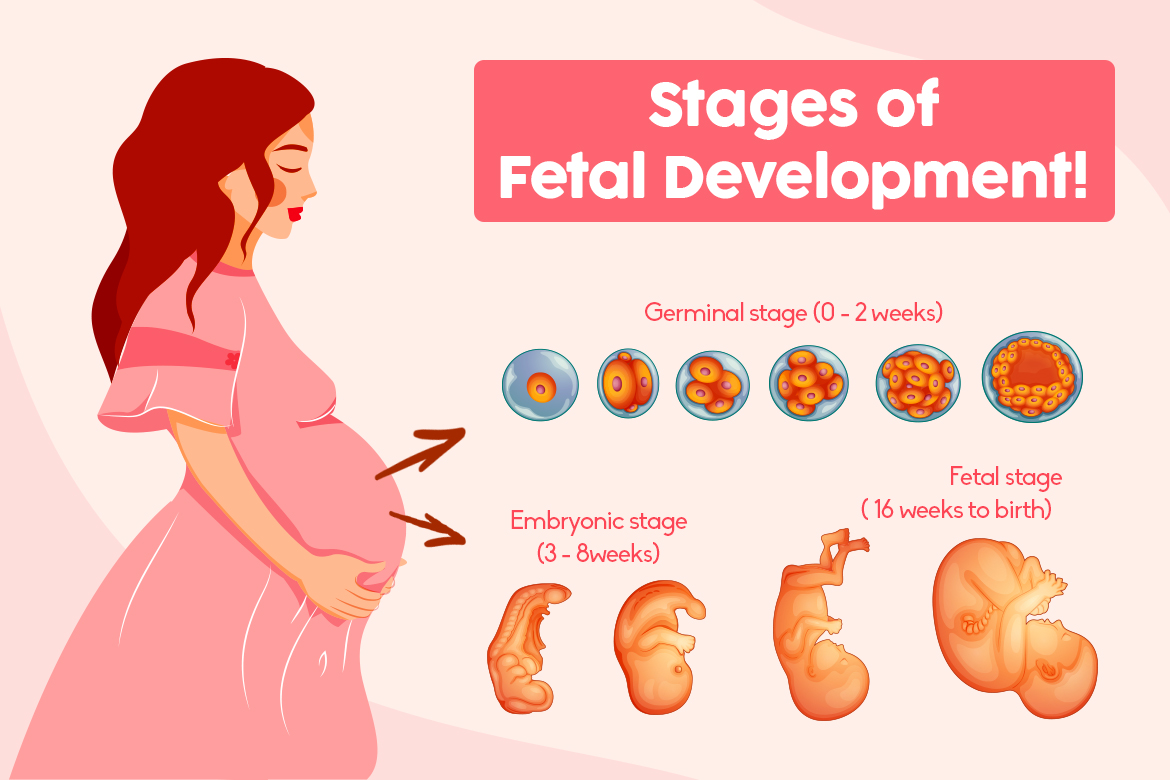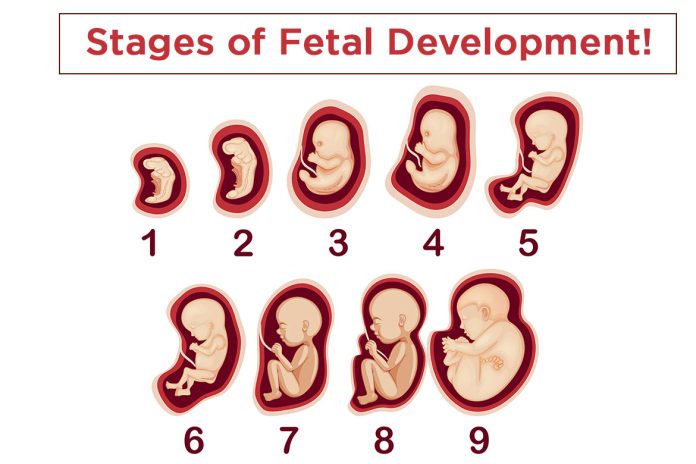Table of Contents
It can be difficult to understand the stages of fetal development. Embryos differ from the fertilized ovum. The main difference is that an ovum or sperm will perish unless merged in the fertilization process, whereas a fertilized egg will develop unless anything goes wrong. The power to reproduce oneself may thus be the initial criterion of life, which the fertilized egg possesses, whereas the individual ovum and sperm do not. The “fetus” is in the tube for the first seven days. It goes through a series of steps that take 38 to 40 weeks to develop into a human baby.
However, there are several myths about stages of fetal development or pregnancy. This blog attempts to provide a week-by-week blueprint of the Stages of Fetal Development.
WEEK 1-2: The Initial Stage
- Conception usually happens two weeks following the start of your last menstruation.
- Your physician will calculate your expected due date by calculating forward 40 weeks from the start of your previous period.
- It implies that even if you weren’t pregnant at the time, your menstruation is a part of your pregnancy.
- It’s vital to remember that you’re not pregnant throughout the first two weeks of your gestation.

WEEK 3: The Fertilization Stage of Fetal Development
- In one of your fallopian tubes, sperm and egg combine to form a single-celled creature known as a ‘zygote.’
- You may have multiple zygotes if more than one egg is discharged and fertilized or if the fertilized egg separates into two.
- In general cases, the zygote has 46 chromosomes: 23 from the birth mother and 23 from the birth father. These chromosomes play a role in determining your baby’s gender and physical attributes.
- The zygote moves through the fallopian tube toward the uterus shortly after fertilization.
- Simultaneously, it will begin to divide, forming a morula.
WEEK 4: Blastocyst Burrows into the Endometrium
- The blastocyst, a quickly multiplying ball of cells, has begun to penetrate further into the endometrium, the uterus lining.
- It is referred to as implantation, and it is one of the most crucial stages of fetal development.
- The embryo will develop from the inner bunch of cells within the blastocyst.
- Most of the placenta will emerge from the outermost surface, which will feed your baby during gestation.
WEEK 5: Rise in the Levels of HCG Hormones
- The HCG hormone levels released by the blastocyst increase dramatically in the fifth week of pregnancy.
- It tells your ovaries to stop producing eggs and start producing estrogen and progestin instead. Increased levels of the hormone cortisol cause your monthly cycle to cease, which is often the earliest symptom of maternity, and stimulate the placenta’s development.
- There are now three membranes to the embryo. Your baby’s outer sheath of skin, middle and peripheral nerve systems, eyes, and innermost ears will all develop.
- The heartbeat and a simple systemic circulation of your baby will develop in the mesoderm, the intermediate stratum of cells.
- Your baby’s limbs, joints, kidneys, and much of the prostate gland will all be built on this layer of cells.
- The lungs and bowels of your baby will develop in the ‘endoderm,’ the inner epithelium.
WEEK 6-8: Head and Nose Develop with the Neural Tube Closing
- The sixth week sees remarkable growth.
- The frontal cortex along your baby’s back is shutting at this stage of fetal development.
- The neural tube is where the baby’s central nervous system grows.
- The heart and other tissues are also beginning to develop.
- The mechanisms required for the development of the ears emerge along with those of the eyes.
- Small buds develop, which will eventually turn into limbs.
- The baby’s body starts to curve into a C-form.
- The baby’s brain and body develop at seven weeks into your gestation.
- The roots of the retinal cells are apparent, and valleys will lead to sinuses.
- Bottom limb buds, which will become feet, have appeared, while arm buds, which sprouted the week before, have taken the shape of flippers.
- Fingers are starting to form. The irises become visible, and little cysts encircling the future shell-shaped parts of the child’s ears emerge.
- The nose and top lip have developed by now. Straightening of the spine and neck begins.
- The baby may be Eleven to Fourteen millimeters long from head to belly by the course of this week.
WEEK 9-10: In this Stage of Fetal Development, Rapid Increase in Toes, Elbows, and Head is Observed
- The baby’s forearms and elbows appear in the ninth week of fetal development.
- The toes are noticeable, and the eyelids are forming. It’s worth noting that the baby’s skull is huge, but their chin is still badly shaped.
- The child’s length from head to buttocks could be between 16 and 18 millimeters here.
- Its head has gotten more spherical by the tenth week of gestation, and its elbows & toes can now flex.
- The umbilical cord is easily noticeable, and the eyelashes and outer ears are still developing.

WEEK 11-12: Officially a “Fetus”
- The baby’s skull still probably accounts for half of its length at the start of the eleventh week of conception.
- Its body, on the other hand, is beginning to grow.
- Furthermore, the infant is now officially a fetus. Its forehead is broader this time, his/her/their eyes are widely spaced, eyelids are fused, and ears are deeply placed.
- Future tooth lobes appear. In the child’s liver, hemoglobin is starting to generate.
- Note that it is in this stage that the baby’s genitalia will begin to grow into a cervix and labia majora, or a penis.
- Its length from tip to toe could be around 50 millimeters at this point.
- The little one is sprouting fingernails, 12 weeks into the stages of fetal development.
- The contour of your child’s face has now become more pronounced. The bowels are in his/her/their abdominal area.
WEEK 13: Second Trimester Begins
- This stage of fetal development marks the start of the 2nd trimester of your pregnancy.
- You can now hear the pulse of your baby.
- Their fingers and toes are well-crafted, and bones are heavier.
- Eyelids, lashes, cuticles, and toenails are produced during this time.
- Your infant can now flex, breathe, and yawn as well.

WEEK 14-19: Muscles Develop, and You Can Tell its Sex
- They weigh around 114 grams by the completion of the 15th week.
- Owing to well-developed genitalia, an ultrasound could now reveal the gender of your baby.
- You will start to look visibly pregnant at this point.
- About the baby- it is now building limbs, and you may notice them moving muscles simultaneously.
- It is covered with vernix caseosa, but don’t panic; they’ll lose this layer right when it is delivered.
- The kid is about 250 grams heavier at this point.
WEEK 20-24: It Starts Kicking!
- You’re nearing the completion of your second trimester at this point.
- Fingerprints of the baby are visible through their mottled skin so that you can see their arteries.
- Remember the small movements they started in the 19th week?
Well, they have evolved into packed kicks now.
WEEK 25: Third Trimester Of Stages of Fetal Development Begins
ENTER: The start of the third and final trimester of pregnancy.
- Because its sensitivity has matured and can now respond to cues, you may notice the baby shifting positions in bright light or noise.
- The fetal fluid begins to reduce about this time.
WEEK 26-36: Internal Organs are Nearabout Developed
- During this time, their eyelids also broaden.
- The baby should weigh between 1 and 1.5 kg by the end of the 29th week.
- Interestingly, it begins to generate bodily fat stores. Also, it can hear and kick a little harder now.
- The formation of the brain and all of its soft tissues are nearly complete. However, lungs are still maturing. The baby should now weigh around 2 kg.
WEEK 37-40: Developed Lungs, Better Reflexes: It is Almost Here!
- Your baby has a stronghold at 37 weeks into your pregnancy.
- Moreover, it may begin to drop into your pelvis in preparation for birth. Make sure its head is pointing downward.
- The thickness of your baby’s brain and belly are nearly the same during these 38 weeks of pregnancy. Its tiny little toes will reach by their cuticles.
- By this stage, it weighs around 11-12 pounds.
- The testicles continue to sink into the groin in boys. For keeping the kid warm after birth, fat will deposit all over his/her/their body.
- It’s all ready to come out!
WEEK 40: Labor and Delivery (An end to stages of fetal development)
- By the conclusion of week forty, all stages of fetal development should be complete.
- Your baby’s head to tail length and weight maybe around 14 inches and 3,400 grams at 38 weeks following birth.
- Don’t be anxious even if your delivery date passed without signs of labor developing.
- It is merely an approximation of when you should be 40 weeks pregnant and does not provide any forecasts about when your child will come.
- Plus, it is very typical to deliver your baby pre or post the expected due date.
Post-delivery, you can start working on your body and get back in a healthy shape again.
The Bottom Line of Stages of Fetal Development
The germinal period lasts for the first two weeks following conception, the embryogenesis stage lasts for the third until eight weeks, and the fetal stage lasts till birth. It is the final period of the pregnancy, which lasts approximately 40 weeks, during which the baby develops the tissues that will later form its neck and face. The circulatory system is still growing in the beginning. The kidneys, intestines, and stomach begin to develop gradually. In this blog on the Stages of Fetal Development, we have covered the details of each of these 40 weeks, starting from gestation to childbirth. However, you should double-check what you are consuming during this period, right from food to water.









